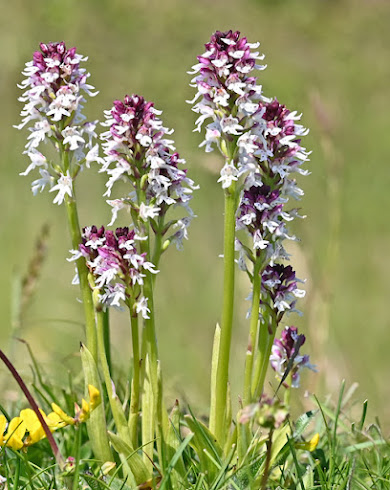The settled weather continued into June, as did the cool, north-easterly wind and lots of cloud, although there was some warmer, sunnier weather over the weekend of the 2nd and 3rd. Things changed from around the 7th, when southerly winds brought in much warmer weather. A heatwave ensued, with temperatures locally reaching 30C. Fortunately, the very wet early spring meant that vegetation remained relatively lush, despite very dry conditions. After a five week drought, some rain finally arrived between the 18th and the 20th, but the heat returned afterwards although with more cloud and the occasional light shower. June is an exceptionally busy month for the general wildlife enthusiast, with invertebrates, mammals and flowers all vying with birds for attention. Consequently, I'll divide this month's blog up into three sections.
Birds
A few late migrants were still coming through the area in the first week, and I had the chance to see and photograph three Black Terns at Dernford Farm Reservoir on the 1st. I flushed a Grey Partridge whilst photographing butterflies on Church Hill on the 4th and was also temporarily distracted by a small bird with an unusual song (a sort of cross between that of a Lesser Whitethroat and a Redstart, but with the tonal range of a whitethroat). The bird turned out to indeed be a Common Whitethroat when I finally had a good view of it. It continued to sing loudly and often in bushes to the west of the Therfield Road for the rest of the month, but sadly it was (presumably) unable to find a partner. House Martins were back at Hatchpen Farm, nesting on the 'new-build' house, on the 13th. Grey Partridges were flushed on The Heath on two further occasions and seen and heard elsewhere. Corn Buntings were singing both at Hatchpen Farm and Greys Farm, although the latter remained a wheat desert. A Cuckoo called a couple of times from just off The Heath on the 19th: this was probably a male on its way back to Africa from further north. Five Coot (two juveniles) were on Phillup's Lake when I visited on the 20th, but the only other bird seen (or heard) there was a moulting male Mallard. Nearby, a Willow Warbler was singing at Reed End hamlet. For me, perhaps the best news was of regular sightings of Spotted Flycatchers on The Heath. Two were seen together in Fox Covert on the 15th, with one (apparently carrying food to a nest site) seen in the same area on the 19th. On the 22nd one, probably two birds were seen on the east side of the Therfield Road. All the birds were adults. I'll keep monitoring the area in the hope of seeing fledged young in the next few weeks.
Butterflies
Adonis and Common Blue numbers on Church Hill and its surrounds remained disappointingly low, although one or two pristine males of the latter species were seen on the 4th, when I also saw my first Meadow Browns of the year. Single Small Copper butterflies were seen in three different areas on the 1st. This is a species that I normally struggle to see locally: are their numbers now increasing, or have I just become better at finding them? Adonis Blues continued to do better at the eastern end of The Heath, where I saw at least a dozen (including two females) in quite a small area on the Old Rifle Range on the 5th. This situation continued throughout the month, with gradually declining numbers of Adonis and Common Blues, as well as Brown Argus butterflies, being seen at the east end of The Heath, but hardly any being seen on Church Hill. As the temperature climbed, insect activity increased. The first Large Skippers were seen on the 12th, with Marbled Whites (15th), Dark Green Fritillaries (19th) and Small Skippers (24th) following. There was a fascinating report of a single Small Blue being seen on the western side of The Heath on the 20th, in an area containing much Kidney Vetch (the food plant of the caterpillars). I have searched this area for Small Blues before (and did so again, after this report) but without success. Has this individual come from a nearby, undiscovered (by me) colony, has a colony always been here or has there been an unlicenced introduction? I have still never seen a Small Blue in the Royston area, although I know that they do occur here on private land. Common Blues showed well on the small wild flower meadow close to my house and I was lucky to see and photograph two beautiful, newly hatched 'blue' females during the month (below).


















